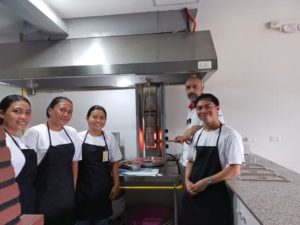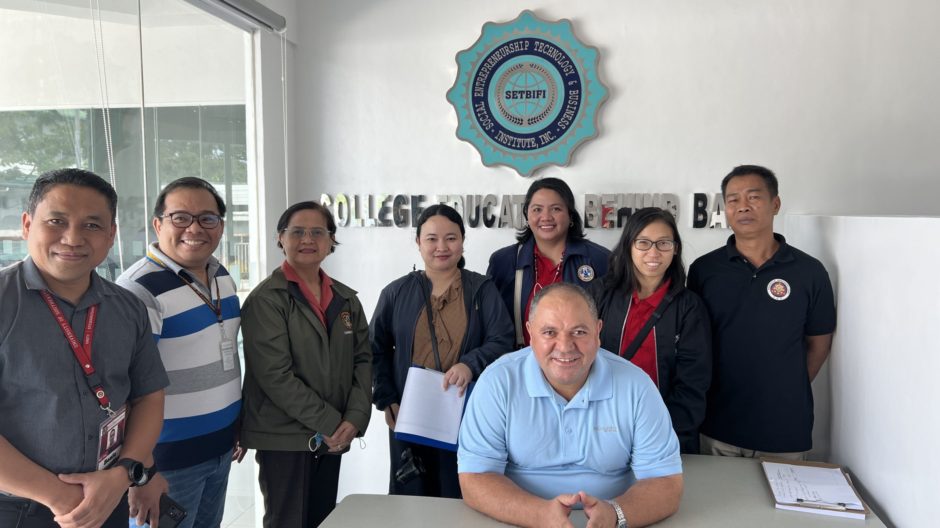



 Minority Care International (MCI) has long been providing financial and advisory assistance to minorities, especially underprivileged members of communities, for broadening and deepening delivery of educational services. The globalization along with the independence of various economies has resulted in creating extra dimensions to the employability skills requirement. Various socio-economic indicators have increased the pressure on vocational education sector and changed it from supply driven to demand driven by the labor market requirement to minimize the existing employability skill gap. Our SETBI Culinary art instructor Chef Ercan Aygun from Turkey teaches group of student’s simple steps for making and mixing Middle Eastern inspired recipes for the mystery Doner Kebab meat you see rotating on vertical rotisseries in Turkish coffee house. Use to stuff into beef or lamb Doner kebabs or Gyrus, Shawarma spreads to homemade condiments, stunning stand alone, delicious vegetablesUnder its new long-term strategic framework Social Entrepreneurship, Technology, and Business Institute (SETBI), an auxiliary of MCI, reaffirms its commitment to stepping up its education sector operations and to contributing to further development of human capital and a skilled labor force in the community. MCI is keen to ensure the development effectiveness of all its operations and that the assistance provided is relevant, responsive, and value-laden. Technical and Vocational Education (TVE) is the education that makes both individuals and the nation self-reliant. In a bid to ensure that TVE proffers a lasting solution to poverty in the Philippines, vocational training or career technical education programs in prison/jails are designed to teach Persons Deprived of Liberty (PDL) about general employment skills or skills needed for specific jobs in industries. The practice is rated according to its effectiveness in reducing recidivism and in having a significant impact on participants by their obtaining employment when released from prison or jail.Most studies show that crime incident and recidivism are inversely related to the educational attainment and employment of the individual. That is, the higher the education of PDL, the less their criminal activities and their rate of return to prison. Overall, the cost benefits of reduced recidivism and lower crime, brought about by education, are believed to outweigh the costs of the education programs for PDL. In other words, it is more expensive to keep PDL inside, especially adding the likelihood of their return to crime and further incarceration, than to educate and rehabilitate them.Work force development is a people-first approach to upskilling workers for long term success. The aim of workforce development it to foster prosperity for individuals, communities, and businesses. Having Technical Education and Skills Development Authority (TESDA) programs inside prison and jails shows that PDLs are considered assets, not just a headcount to perform a specific task or purpose. Focusing on developing skills is not enough for businesses to stand out in such competitive times. The markets are changing too quickly, and the rate of reskilling is not catching up. Therefore, a workforce development approach that focuses on personalized learning, experiences, leadership, and growth is needed. TESDA programs must be integrated with business strategy and consistently re-evaluated to align with the changes in the modern global market. At the macro level, work force development also refers to employment initiatives provided by government agencies to support national economic growth.
Minority Care International (MCI) has long been providing financial and advisory assistance to minorities, especially underprivileged members of communities, for broadening and deepening delivery of educational services. The globalization along with the independence of various economies has resulted in creating extra dimensions to the employability skills requirement. Various socio-economic indicators have increased the pressure on vocational education sector and changed it from supply driven to demand driven by the labor market requirement to minimize the existing employability skill gap. Our SETBI Culinary art instructor Chef Ercan Aygun from Turkey teaches group of student’s simple steps for making and mixing Middle Eastern inspired recipes for the mystery Doner Kebab meat you see rotating on vertical rotisseries in Turkish coffee house. Use to stuff into beef or lamb Doner kebabs or Gyrus, Shawarma spreads to homemade condiments, stunning stand alone, delicious vegetablesUnder its new long-term strategic framework Social Entrepreneurship, Technology, and Business Institute (SETBI), an auxiliary of MCI, reaffirms its commitment to stepping up its education sector operations and to contributing to further development of human capital and a skilled labor force in the community. MCI is keen to ensure the development effectiveness of all its operations and that the assistance provided is relevant, responsive, and value-laden. Technical and Vocational Education (TVE) is the education that makes both individuals and the nation self-reliant. In a bid to ensure that TVE proffers a lasting solution to poverty in the Philippines, vocational training or career technical education programs in prison/jails are designed to teach Persons Deprived of Liberty (PDL) about general employment skills or skills needed for specific jobs in industries. The practice is rated according to its effectiveness in reducing recidivism and in having a significant impact on participants by their obtaining employment when released from prison or jail.Most studies show that crime incident and recidivism are inversely related to the educational attainment and employment of the individual. That is, the higher the education of PDL, the less their criminal activities and their rate of return to prison. Overall, the cost benefits of reduced recidivism and lower crime, brought about by education, are believed to outweigh the costs of the education programs for PDL. In other words, it is more expensive to keep PDL inside, especially adding the likelihood of their return to crime and further incarceration, than to educate and rehabilitate them.Work force development is a people-first approach to upskilling workers for long term success. The aim of workforce development it to foster prosperity for individuals, communities, and businesses. Having Technical Education and Skills Development Authority (TESDA) programs inside prison and jails shows that PDLs are considered assets, not just a headcount to perform a specific task or purpose. Focusing on developing skills is not enough for businesses to stand out in such competitive times. The markets are changing too quickly, and the rate of reskilling is not catching up. Therefore, a workforce development approach that focuses on personalized learning, experiences, leadership, and growth is needed. TESDA programs must be integrated with business strategy and consistently re-evaluated to align with the changes in the modern global market. At the macro level, work force development also refers to employment initiatives provided by government agencies to support national economic growth.
Without the strong establishment of pathways into the labor force, individuals exit the prison system severely underprepared and thoroughly handicapped by the sentenced they have already completed. All PDL should be treated with the respect due to their inherent dignity and their value as human beings, according to the first of the Basic Principles of the Nelson Mandela Rules that are the United Nations’ standard of minimum rules for the treatment of PDL. The educational opportunities in prison are key to reducing crime and decongesting the prison population as well. If we are to view the prison/jail system as an instrument of justice and a deterrent from criminality activity, it should be the case that PDL’s punishment for committing a crime should end when they are released and not last for the rest of their lives. Individual PDL are often at the very bottom of the socio-economic ladder. This contributes to poor economic mobility because of a lack of training skills, a high level of unemployment, and a high rate of recidivism.
The majority of the PDL tend to be undereducated and underemployed compared to the general population. Many of the people entering prison do not have a high school degree or general education credentials. The disparity for postsecondary education is even greater, where the rate at which adults have an associate’s degree or more is four times higher than what has been observed for PDL.
SETBI partnered with TESDA to play a crucial role in developing a skilled workforce through preparation. The question is how is the TESDA ensuring that they are addressing current workforce and industry needs and making sure many of the programs are not redundant. Getting people ready for future jobs is about much more than helping them to find work. It is about equipping them to be life learners and giving them the skills to adopt to a rapidly changing employment market. The success of the technical and vocational education system lies in its coordination with industry and in its producing graduates with skill sets that are required by industry. The best practice of a technical and vocational education system is to take industry on board and understand what the market demands of these businesses. To this end, SETBI combats a lack of workforce readiness so that:
- PDL undertaking TESDA courses may expect better labour market futures. Integrating initiatives that set up new apprenticeships encourages the development of agents of change.
- PDL are able to upgrade their skills, including completing the schooling they did not have access to when they were outside, as well as to undertake further studies up to the postgraduate level. Many see their studies as an exit from low-wage employment, particularly those taking up College Degree programs or TESDA training programs.
- Most PDL also engage in work, primarily as a result of the financial incentives of gratuities. However, this work has traditionally been seen as a prison management tool to occupy PDL during the day rather than for the purpose of upskilling poorly qualified PDL.
- Most of the TESDA training programs that are offered for PDL relate to their maintenance, for example, cooking, cleaning and gardening. Cleaning and catering are important as well, but those should be commercially based and offer specific skills training with employment potential.
- The teachers must possess current and relevant skills, attitudes, orientation, and innovation in teaching because education must be relevant to the needs and aspirations of the society.
- There should be adequate funding of TVE programs, and entrepreneurs should be encouraged with soft loans. The societal negative perception can be changed only if it is able to see the achievements of those who are already trained in the field.
- There should be periodic review of the curriculum content of TVE. The review could be done every five years to ensure that TVE curriculum is relevant to the needs and aspirations of the nation.
- The government should provide the necessary equipment, machines, facilities, and infrastructure needed in the effective teaching and learning of vocational and technical education.
- There should be an adequate supply of qualified staff to teach in the program.
- Schools need to be adequately equipped with good teaching and learning environments, workshops, laboratories, and good libraries—all available to make teaching and learning easy, enjoyable, and delightful for both teachers and students.
- Undoubtedly this is a great step in promoting technical and vocational education all over the Philippines.

